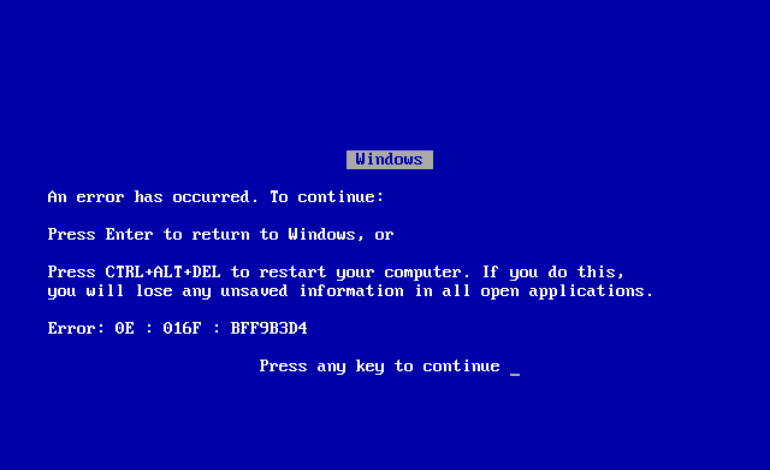GAME_JAM Ctrl + Alt + Delete
Imagine you are making a game. So, for the purposes of this crude analogy, think of yourself as a game developer.
Now, you have a game design document or GDD: a document made as an outline for a team in order to put a specific kind of game together. You, or a group of people supporting you, can add different additions, adjustments and clauses for the purpose of customizing your GDD and expanding it into a game that is your own.
All right, now imagine your GDD, the source that you are working from, is a Game Jam. And what is a Game Jam? A Game Jam can be seen as a space where various people–graphic artists, audio makers, programmers, and even writers–come together and with a prompt, or no prompt at all, make a game of some kind in a small amount of time. More often than not, groups of developers and creators pair themselves up before the event and have known each other for a while: creating close-knit relationships with each other ranging from working together all the way to the point of friendship. The idea of a Game Jam is to have a small window of time in which you not only get to experience spontaneous creativity in an inclusive and friendly environment but also potentially reaffirm relationships and even make new friends and contacts with a game-making community.
Now, bear in mind that every Game Jam is different. It either has a different theme, or it’s sponsored by external sources, or it is run from the houses of friends who decide to get together and make games while socializing and sharing ideas. While some Jams can theoretically have anyone of any experience level, including newbies, as participants other Jams require creators to have prior expertise before attending. One such group of the latter, with the assistance of YouTube companies such as Polaris decided to create a special Jam that could illustrate, to a larger viewing audience, exactly how some of this “spontaneous creative process” might work and, hence, demystify and even fascinate people with how ultimately a Game Jam can work.
So keep thinking of this idea of a reality-television Game Jam, called GAME_JAM, as a GDD. Imagine that some marketing directors, having never made or played a video game before, decided to add their own additions and clauses into the GDD and overrule the original creators (which, unfortunately, is a common occurrence within the industry at least). Think of these additions as analogous to the contracts with GAME_JAM participants that, if signed, would force them to–among other things–allow themselves to be “misrepresented for dramatic purposes” ala “reality-television,” not be able to promote their own independent work based on the show during this time, and always having to promote their sponsors such as Mountain Dew to the point of needing to drink it in front of the cameras that were everywhere save for bathrooms and bedrooms.
Think of what the presence of “dramatic misrepresentation” can do as well. Basically in this case, it attempts to take the spirit of cooperative gaming, and turn it into a player verses player situation with neither warning nor consent. I think, even if you aren’t a game developer, it can be safe to say that this structure is jarring and very self-contradictory: to the point where even if the clauses are tweaked, the original flaw in the messy structure that was the original conflict still remains.
But these elements in themselves didn’t necessarily mean that GAME_JAM would end. Many of the participants and group leaders such as Zoe Quinn the creator of Depression Quest, Davey Wreden of The Stanley Parable and others were and are creative enough, when motivated, to work with production: to collaborate in order to make a more unique “game” as it were.
But now think about this already inherently unstable game structure which already compromises the spirit of open space of creativity due to a certain degree of production micromanaging.
And then, something bad happens. And this something bad occurs long after the Game Design Document of GAME_JAM becomes a program in its own right.
It comes in the form of one of the more boisterous and obnoxious market directors. This Trojan virus in consultant’s clothing as it were, decides to place utilize and push for Digital rights management software or DRM that compromises the operating system that the game will be run on. It may have even seemed like productive software at the time and helped GAME_JAM and its sponsors. Even the production companies know that this particular form of DRM, in the form of one Matti Lesham of Protagonist’s attitudes, is potentially harmful but they have always tolerated it: a creative consultation program that is really a commercial program that gets clicked on and fills your computer with incessant ad ware, and intrusive spyware and worse: virulent malware.
It is this malware; composed of deceptive queries such as “Do you think you’re at an advantage because you have a pretty girl on your team?” and “Do you think the teams with women on them are at a disadvantage?” that completely corrupts the original GDD’s ideal of an open, safe, and inclusive space of creation.
And this was what ultimately caused GAME_JAM to crash.
And when it comes down to it, its participants let it crash.
Perhaps anyone else would have let the computer downstairs languish with its offensive pop-ups, its hostile injection of lag between creative processes, incessant ads and its corrupted programming except none of these other people would have been game developers or game makers. More specifically, none of these people would have been professionals.
And GAME_JAM was filled with independent developers and makers–friends and professionals of quality art–that didn’t like to deal with having their space impinged upon, or being told what to do, or dealing with someone attempting to create conflict through antiquated, misogynist hate-speech spam. Perhaps a home owner might ignore the virus on the computer they are forced to use, but a programmer would go after it and delete it mercilessly. What GAME_JAM ultimately became as a result of all the above was an unplayable mess and an extended and non-consensual trouble-shoot. The system that was GAME_JAM, even with the overt flaws removed in the form of Matti Lesham’s dismissal, was still too corrupted and buggy to prevent anything like the contradictions that allowed the infection to begin with: a whopping $400, 000 assessment.
Nevertheless, this mistake of a game taught its players and creators something. It made them go back and look at the original Game design document that was intended from the start. And they looked at it. They really looked at it, and themselves, and what they were capable of. It taught them how not to create a game and how to make a game–or a game jam–that hearkened back to its GDD: one of mutual cooperation, acceptance, friendship, and an intolerance for conformity and bigotry. GAME_JAM might have become unplayable but those involved with it will hopefully not only play other, better games but even allow themselves to make them: with everyone on-board for its conceptual phase.
Back to the drawing board Game Design Document.
For more nuanced information with regards to what happened with GAME_JAM please check out Jared Rosen’s Indie Statik article How the Most Expensive Game Jam in History Crashed and Burned in a Single Day. He was a games journalist that documented what happened at the event. The bottom of his article has links to other participants’ perspectives on the event as well. You can also look at Rami Ismail’s Polygon article A warning about contracts from the sidelines of the most expensive game jam in history and Colin Campbell’s How ‘Game Jam,’ an indie game dev reality show, collapsed on its first day of filming for good measure.







